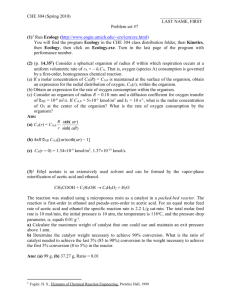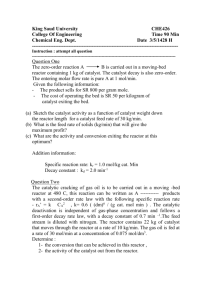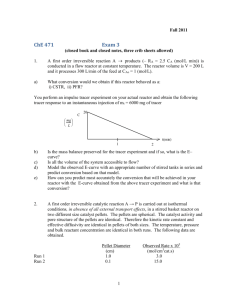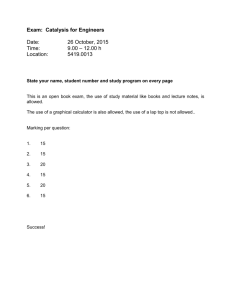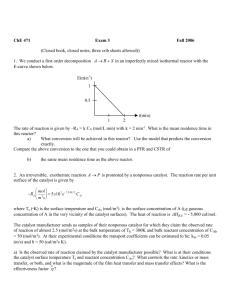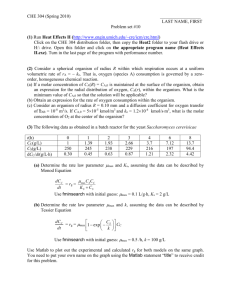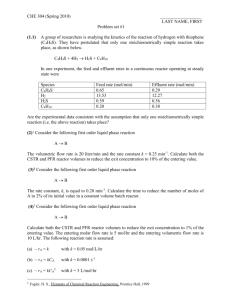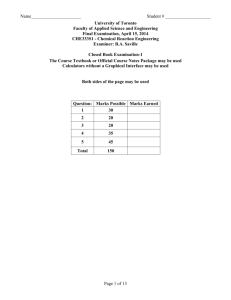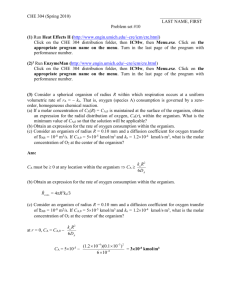here
advertisement
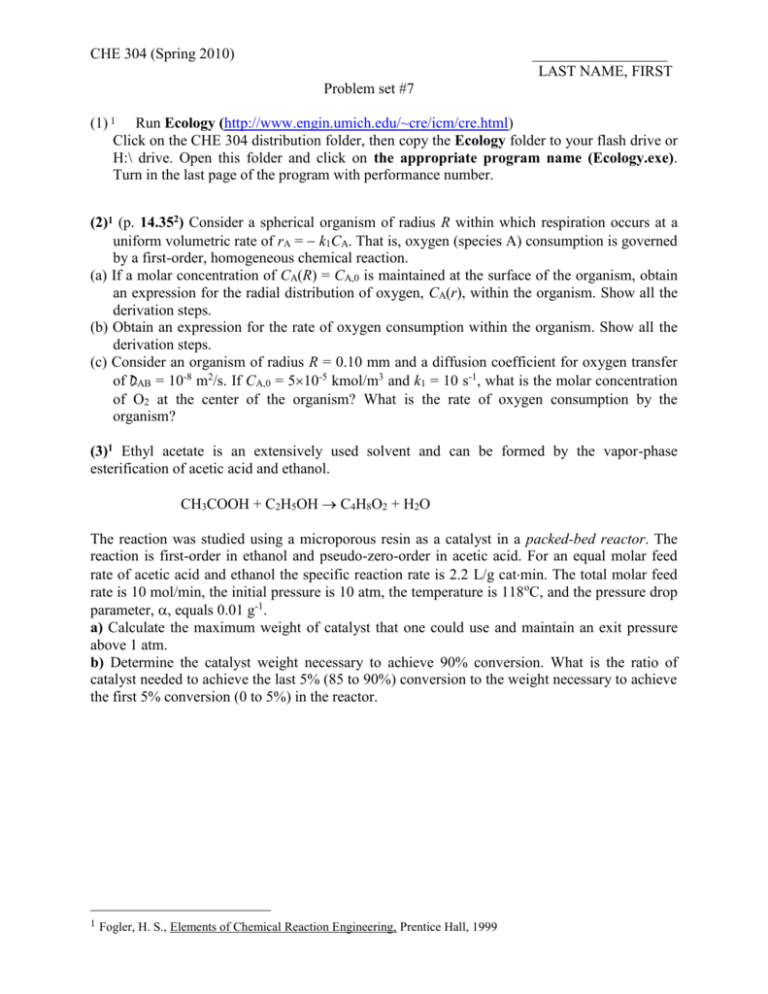
CHE 304 (Spring 2010) __________________ LAST NAME, FIRST Problem set #7 (1) 1 Run Ecology (http://www.engin.umich.edu/~cre/icm/cre.html) Click on the CHE 304 distribution folder, then copy the Ecology folder to your flash drive or H:\ drive. Open this folder and click on the appropriate program name (Ecology.exe). Turn in the last page of the program with performance number. (2)1 (p. 14.352) Consider a spherical organism of radius R within which respiration occurs at a uniform volumetric rate of rA = k1CA. That is, oxygen (species A) consumption is governed by a first-order, homogeneous chemical reaction. (a) If a molar concentration of CA(R) = CA,0 is maintained at the surface of the organism, obtain an expression for the radial distribution of oxygen, CA(r), within the organism. Show all the derivation steps. (b) Obtain an expression for the rate of oxygen consumption within the organism. Show all the derivation steps. (c) Consider an organism of radius R = 0.10 mm and a diffusion coefficient for oxygen transfer of DAB = 10-8 m2/s. If CA,0 = 510-5 kmol/m3 and k1 = 10 s-1, what is the molar concentration of O2 at the center of the organism? What is the rate of oxygen consumption by the organism? (3)1 Ethyl acetate is an extensively used solvent and can be formed by the vapor-phase esterification of acetic acid and ethanol. CH3COOH + C2H5OH C4H8O2 + H2O The reaction was studied using a microporous resin as a catalyst in a packed-bed reactor. The reaction is first-order in ethanol and pseudo-zero-order in acetic acid. For an equal molar feed rate of acetic acid and ethanol the specific reaction rate is 2.2 L/g catmin. The total molar feed rate is 10 mol/min, the initial pressure is 10 atm, the temperature is 118oC, and the pressure drop parameter, , equals 0.01 g-1. a) Calculate the maximum weight of catalyst that one could use and maintain an exit pressure above 1 atm. b) Determine the catalyst weight necessary to achieve 90% conversion. What is the ratio of catalyst needed to achieve the last 5% (85 to 90%) conversion to the weight necessary to achieve the first 5% conversion (0 to 5%) in the reactor. 1 Fogler, H. S., Elements of Chemical Reaction Engineering, Prentice Hall, 1999 (4)2 The gas phase catalyzed hydrogenation of o-cresol to 2-methylcyclohexanone is given by o-cresol(A) + 2H2(B) 2-methylcyclohexanone(C) The reaction rate on a nickel-silica catalyst was found to be rA = kPB, where k = 1.74 mol of o-cresol/(kg catminatm) at 170oC The reaction mixture enters the packed-bed reactor at a total pressure of 5 atm. The molar feed consists of 67% H2 and 33% o-cresol at a total molar rate of 40 mol/min. Neglecting pressure drop, use Matlab to plot the rate of reaction of o-cresol and the partial pressure of each species as a function of catalyst weight (to 4.8 kg). You need to put your own name on the graph using the Matlab statement “title” to receive credit for this problem. What is the ratio of catalyst weight needed to achieve the last 5% conversion (from 93 to 98%) to the weight necessary to achieve the first 5% conversion (from 0 to 5%) in the plug-flow reactor? 2 Roberts, G. W., Chemical Reactions and Chemical Reactors, Wiley, 2006 (5) When the isomerization of normal pentane (n-C5H12 i- C5H12) is carried out in the presence of hydrogen at 672 K and total pressure of 500 psia over a catalyst composed of a “metal deposited on a refractory support,” the kinetics are adequately described by the rate equation p k pn i K mol rn 2 = g cat hr 1 K H 2 pH 2 Ki pi K n Pn In this equation, pi and pn are the partial pressure of isopentane and normal pentane, respectively. At 672 K, the value of the constants in the above equation are: K = 1.632, k = 2.0810-3 (mol/gcathrpsia), KH2 = 2.2410-3 (psia)-1, Kn = 3.5010-4 (psia)-1, and Ki = 5.9410-3 (psia)-1. The fractional conversion of n-pentane to iso-pentane in the reactor effluent must be 95% of the maximum possible conversion. The feed to the reactor will be a mixture of hydrogen and npentane in the ratio 1.5 mol H2/mol n-pentane. No other compound will be present. Determine the value of the required space time, = (WCA0/FA0), if (1) the reactor is an ideal PFR and (2) the reactor is an ideal CSTR. Ideal gas laws may be assumed with Rg = 1206 psiacm3/molK. Use seven point Simpson’s rule for the integration of the PFR. (6)4 A bacterium 1 m in diameter digests glucose from the surrounding nutrient to produce the body mass needed to divide. Calculate the time required for cell division if cell growth occurs by the reaction glucose mass + byproducts The growth rate is limited by diffusion of glucose (DA = 110-6 cm2/s) around the cell which is in a stagnant environment with a bulk glucose concentration of 510-7 grams/cm3. Assume that the density and molecular weight of the cell are those of water and that 5 grams of cell mass are formed for every gram of glucose consumed. 4 Kyle, B.G., Chemical and Process Thermodynamics, Prentice Hall, 1999 (7) 1The renal dialysis machine or artificial kidney can be used to treat patients with uremia or renal failure. During kidney dialysis blood flows through a system of tubes composed of a membrane permeable only to the smaller solutes but not the plasma proteins. On the outside of the dialysis tubes is a dialyzing fluid that contains the same concentration of solutes as the plasma, except for the metabolic waste products. As a result, metabolic waste products diffuse from the blood into the dialysis fluid due to the concentration (or more exactly chemical potential) gradient for these substances from the blood to the dialysis fluid. Blood is usually taken from an artery at a high pressure, passed through the dialysis machine, and then returned to a vein at a lower pressure. At some time during the dialyis of a patient in kidney failure, the aeterial and veuous blood conditions are as follows: Flow rate, ml/min Urea concentration, mg/ml Arterial blood 200 2.1 Venous blood 195 1.2 a) Calculate the rate at which urea and water are being removed from the blood. b) If the dialyzing fluid enters at the rate of 1500 ml/min and the exiting dialyzing solution (dialysate) leaves at about the same rate, calculate the concentration of urea in the dialysate. Suppose we want to reduce the patient’s urea level from an initial value of 2.7 mg/ml to a final value of 1.1 mg/ml. If the total distribution volume is 40 liters and the average rate of urea removal is that calculated in part (a), how long must the patient be dialyzed? (Neglect the loss in total blood volume due to the removal of water in the dialyzer.)
